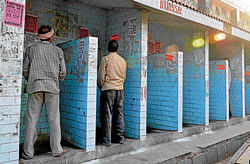Kids suffer as some loos are dirty, others remain locked
Bano, a class 11 student, laments that despite several complaints to her school principal and teachers about dirty toilets, there have been no attempts to ensure that they are cleaned.

“There are close to 1,800 students in my school. Since toilets are not cleaned regularly, we wait till the school hours are over and use the bathroom at our home,” adds Bano who is studying at a government school in Delhi.
Children at government schools across the city have similar complaints. Juhi, a class 8 student, says her school has new toilets but they remain locked as they are used by the staff. Kids at her school are forced to urinate in the open or in playgrounds.
Educationists say government doesn't spend enough on infrastructure in Delhi schools.
“There are shortcomings but it is not appropriate to blame teachers for everything.
Some of the teachers in government schools shell out money from their pockets to hire cleaners as there is a shortage of them. The government is not giving us enough resources,” says R C Dabhas, vice president of All India Primary Teachers Federation.
He adds there are still no separate toilets built for children with disabilities, which is one of the major parameters for the implementation of Right to Education Act.
According to a study by Child Rights and You (CRY) and its partner NGOs in March, 37 per cent of 318 toilets across 400 government schools covered under the survey were not usable – as they were dirty and not cleaned regularly – and 15 per cent were reserved for the school staff, making them out of bounds for children.
Only 39 per cent of the toilets were cleaned regularly whereas 61 per cent were cleaned occasionally or twice a month, 24 per cent lacked water supply and 21 per cent had infrastructural problems like blocked sewerage or broken doors.
The survey also revealed that schools in north-west, north-east and outer districts of Delhi were mostly unclean, and several schools in south-west did not have buckets and mugs.
Another report by Dasra Foundation in August highlighted that lack of toilets and basic infrastructure at schools is a major cause of high school dropout rates.
Ambareesh Rai, convenor of RTE forum says: “Separate toilets for girls are a must to correct dropout rates but nothing is being done in this area either by the government or the municipal bodies.”
In response to the issue of unhygienic toilets across MCD schools, Rekha Gupta, chairperson of the North Corporation’s education committee says: “Though all our schools have toilets, we admit that cleanliness is an issue at some schools. So we have decided to outsource sanitation and maintenance work to private service providers.”
She admits each school has only one safai karamchari when more than four lakh students study across Municipal Corporation of Delhi schools.
The South Corporation has decided to introduce e-toilets in its schools based
on a model being used by schools in Kerala, for which they might seek help from NGOs for better implementation of the project.
During the budget speech this year, the MCD had announced that 68 toilet blocks at schools had been constructed as of October 2011 while work was going on for 340 more. And in the 2012-13 budget, 100 toilet blocks were proposed.
Deccan Herald is on WhatsApp Channels| Join now for Breaking News & Editor's Picks